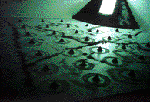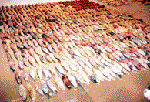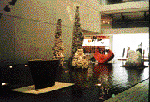The tenth Sydney Biennale--entitled "Jurassic Technologies Revenant" and directed by Dr. Lynne COOKE of the Dia Center for the Arts--took as its focus image-making in the electronic age, an era when radical revision of the forms of visual representation has proceeded apace. The theme calls to mind high technology arts, but on the contrary COOKE stressed the "revenant" of conventional reproductive-technology media. At a time when electronic technologies are flashing to prominence, these technologies "revenant"-- which are opening up a new dimension for artistic expression through reflection on their own media--include photography, film, and video, and by extension of the concept of reproductivity, prints, textiles and architecture as well.
COOKE raises doubts about the disruptive possibilities of the 'linear time,' 'space,' and 'subjectivity' of cyberspace, and insists on the physicality of the medium and the corporeality of the viewer as foundations for the visual arts that must not be neglected. Invoking Roland BARTHES' discussions of photography, COOKE examines the damage, losses, and changes that the material undergoes and draws out the aspect of the "presence/absence" of the work. This aspect in turn implies a "transience" inherent to the temporality of the event. COOKE's aim in planning the show was to apply the temporality of "presence/absence" to media other than photography.
Ann HAMILTON's "Filament" consists of black gauze in the shape of a giant skirt that turns under the power of a motor, then stops after a period of time, repeating this movement over and over. The material is soft and thin as a lace curtain and creates a sensual impression. Once this seductive medium begins to revolve, it cuts the viewer off from its inner space. When the revolution stops, the scene one has been watching returns to static inexpressiveness. The manifestation of a "fragile," "transient spectral" scene (COOKE). Like HAMILTON's previous works, this fleeting scene excites senses other than the visual (here, the tactile and auditory) as it touches the domain of our internal memories.
From the point of view of "transience," animations by South African artist William KENTRIDGE--created through the low-tech methods of a series of free-hand drawings--stood out. While a single drawing does not move itself, KENTRIDGE repeatedly erased and redrew portions to pursue surrealistic metamorphoses. The story ultimately advances in a linear fashion along with time, but the flow of the images moves subtly forward and back. The movements of this work brought Karl SIMS' animation of Leonardo DA VINCI's "Flood" to mind. Far from being atemporal, the "drawing" that is the foundation of animation is shown to possess a flow of lived time and a corporeal end. This "transience" is the source of the sense of solitude of KENTRIDGE's work.
 Tony OURSLER exhibited a work consisting of an eye-object placed directly on the floor. Video is projected onto the eye, turning it into an eyeball-shaped screen. The eye itself thus becomes a metaphor for film. Because the frame of a film is faintly visible on the left edge of the eye, one is aware that this is a human eye watching a film. The eye moves in response to the film that it is watching, regardless of the intentions of the model, thus signifying the intersection between the person watching the film and the people moving inside it. Rather than reducing the eyeball to a transparent medium of visual perception, the work draws the flesh itself, possessed of a weight and a living thickness, out of the domain of the invisible.
Tony OURSLER exhibited a work consisting of an eye-object placed directly on the floor. Video is projected onto the eye, turning it into an eyeball-shaped screen. The eye itself thus becomes a metaphor for film. Because the frame of a film is faintly visible on the left edge of the eye, one is aware that this is a human eye watching a film. The eye moves in response to the film that it is watching, regardless of the intentions of the model, thus signifying the intersection between the person watching the film and the people moving inside it. Rather than reducing the eyeball to a transparent medium of visual perception, the work draws the flesh itself, possessed of a weight and a living thickness, out of the domain of the invisible.
According to COOKE, our human fleshly-corporeal thickness, which lives the temporal limitations of "presence/absence," is what lines with the themes that conventional reproductive-technology media are treating openly in contemporary art, such as history as social memory, gender, and differences within multicultural society. (*1)
The second Asia-Pacific Triennial of Contemporary Art in Brisbane follows the inaugural Triennial in 1993, and is expected to be succeeded by a third planned for 1999. The great repercussions and influence of the first triennial are reflected in the number of countries and artists participating in the present exhibition, as well as in the expansion of texts in the exhibition catalogue.
Indonesia's Marintan SIRAIT staged a performance on the day of the opening reception. In a space composed of small mounds of black soil surrounded by rings of white sand, the artist danced as if crawling across the earth a crawling dance while scattering black soil. The installation of the work was completed only after the performance in which this sand painting was discontinued. After performing alone for some time, the artist passed the soil he was holding in his clasped hands to a spectator, who then stepped onto the floor that served as a stage and began scattering the soil. Several others were encouraged to do the same, and the spectators continued to spread soil about, two or three people at a time. To call this a picture is rather confusing, but the activity invoked a solemn atmosphere. In the right back corner where the soil was piled up, the artist stripped off newspaper covering a fluorescent light by rolling it up from the bottom, and left the space (then finished). Torn scraps of newspaper remained on the walls as well; the articles appeared to be concerned with social problems that erupted with modernization. The visual art performance that SIRAIT staged (this is one of several artistic movements that recently have become popular in Indonesia) suggested the theme of "Building a house." After returning to Japan, I knew by intuition that the spectators who were given soil and who spread it in the space may have been made to play the role of the historical-cultural conqueror who as an other invaded the national soil and brought--or now is bringing--desolation to it. Those who participated in this activity, as well as those of us who witnessed it, may indeed have been taken in by the artist's shrewd strategy.
The Triennial is organized with the goal of political and economic coexistence in the Asia-Pacific region in the background. The Australian curators extoll cooperative curation with local specialists, and are trying to build a vast Asia-Pacific database through networks. The approach of the Queensland Art Gallery, to carry out a reflection on "orientalism" through a formal positivistic survey, certainly is legitimate but has the consequence of forcefully imposing the rationalistic classifications of Western art history. Needless to say, the curators of the Triennial are aware of the need to avoid the sterility of political correctness and to interpret it only after the fact. But it is difficult to escape neither the fact that the very classifications that organize the artists' themes, intentions, materials, and so forth, carry a degree of danger of stereotyping the artists' ethnic-cultural identifies, nor, moreover, the reality that as a consequence of marketing, the systematization of Asia-Pacific art tends toward the homogenization of value as consumption. Indeed, this hidden violence of the cultural imperialism that is implicit in capitalistic consumptive culture is felt a danger by acute, post-colonial sensibility of this region.
As an ironical response to the standardization of the image and the violence of classification, Singapore's ZAI Kuning offered some 200 wax objects, minutely different from each other in shape, arrayed on the floor and hanging from the walls. In contrast to these strange solids the extremely bright lighting in the installation emphasized the abstract exhibition space, recalling a show window. In the past this artist has reported on the sealing of art objects in Singapore and proposed antitheses to the commodification of the work. This naive "resistance to classification" takes as its target the art-museum system in which works are classified and subjected to exhibition.
The eye directed at social structure is in one sense directed toward a questioning of the programming of the system itself and toward the problematics of input and output in information. In "Model," China's WANG Jian-weiplaces display an analytical computer-graphic image of an organic cell on a bed of medical examination that moves reciprocally backward and forward. A video of actual flies is projected intermittently in front of the bed. A cell, a cross-section of the brain, the production of spermatozoa according to information conveyed from the brain, and their movement and so on. The internal informational process simulated here is dissected by a cool eye (the camera) toward the material foundations of society, and calls to mind issues of universality and particularity in the biological world and in society, evolution, birth, sexual difference, and even majority and minority.
A piece by China's WANG Luyan, departing from changes in bicycle models; "Nation for Sale," an installation by Indonesia's ARAHMAIANI taking cultural imperialism as its acrimonious theme; a mountain of miniature created in gypsum for the interior by Francesca ENRIGNEZ of the Philippines, and her reproduction of an entire interior-design catalogue in oil paintings. These works all employ objects from consumer culture. These objects resurrect cultural memory and give form in the present to new interpretations of and witnesses to history (this overlaps at points with the socio-political photo-collages of YAMASHITA Kikuji in Japan at one time and appropriation of documentary films of historical events by YOOK Keun Byung in South Korea.)
Exposing the fictionality of the single communal history, Malaysia's WONG Hoy Cheong shows the psychological cleavage between classes through arrangements of social icons representing opposed ethnic groups and classes (after experimentation on a computer, these are turned into tableaux). WONG poses the question, "How the individual 'I' become[s] the collective 'I'?" In awareness of social memory as corporeal and psychological oppression, the pursuit of this question is carried out by the practices of demythicization by strategic appropriation.
"Sydney Biennale--JURRASIC technologies revenant" was open from July 27, to Sept. 22, 1996, at the Art Gallery of New South Wales and other spaces.
"The Asia-Pacific Triennial of Contemporary Art" opened Sept. 27, 1996, and closes Jan. 19, 1997, at Brisbane's Queensland Art Gallery.
Note:
*1: ......Lynne Cooke, 'Embodiments,' in JURASSIC technologies revenant, 10th Biennale of Sydney (exhibition catalogue), 1996, pp. 53-61.
(KAMIKANDA Kei, Aesthetics and Art History)
Translated: Christopher L. HILL
Sydney Biennale home page:
http://www.sydneybiennale.geko.net.au/
Asia-Pacific Triennial of Contemporary Art home page:
http://www.slq.qld.gov.au/qag/apt/welcome.htm
 Maritan SIRAIT
Maritan SIRAIT ZAI Kuning
ZAI Kuning ARAHMAIANI
ARAHMAIANI WANG Jian-wei
WANG Jian-wei




